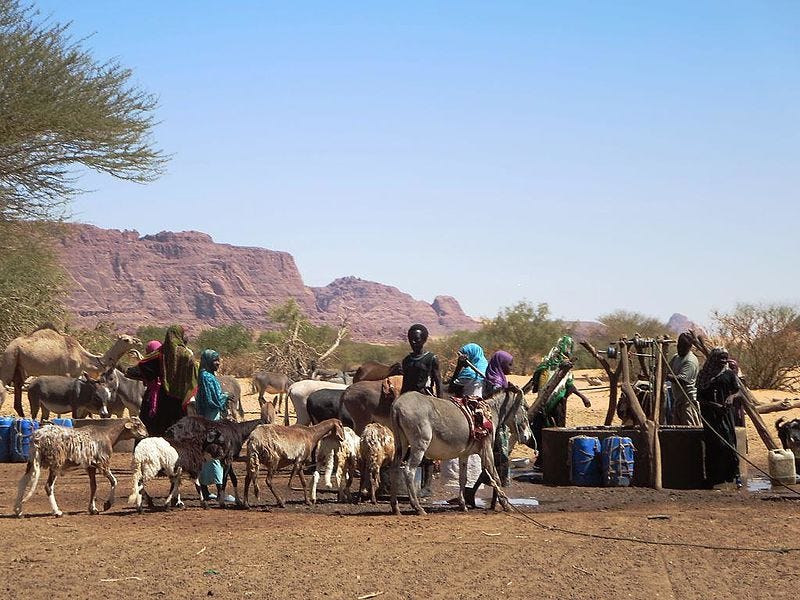Image of the Day

Market Mondays
🔴 Johannesburg SE: 76,851.78 (-0.05%)
🟢 Nigerian SE: 99,221.14 (+32.70%)
🟢 Nairobi SE: 114.60 (+24.42%)
🟢 Ghana SE: 3,772.10 (+20.51%)
🟢 US S&P 500: 5,346.99 (+12.74%)
🟢 Shanghai Composite: 3,051.28 (+3.00%)
Ivory Coast, the world's top cocoa producer, has decided that chocolate isn't enough to keep its economy afloat. In 2023, the country hit a record high in gold output, thanks to the opening of new mines.
Nigeria is grappling with a different kind of challenge: keeping petrol prices fixed. The country is expected to spend $3.7 billion in 2024 to maintain the price freeze, a 50% increase from 2023.
Zambia, one of the African countries hit hard by the El Niño-induced drought, has turned to the International Monetary Fund (IMF) for help. The government has asked for its $1.3 billion loan program to be increased to $1.7 billion to assist in responding to the severe drought.
Despite the challenges posed by climate change, geopolitical tensions, global inflation, and rising debt, Africa's economic growth is set to accelerate to 3.7% this year and 4.3% next, according to African Development Bank (AfDB) President Akinwumi Adesina. The AfDB is also helping to raise $3.2 billion for the East Africa standard gauge railway and providing $500 million for the development of the Lobito Corridor.
The World Bank has been busy in Africa, approving a $1.2 billion budget support package for Kenya to help address short-term fiscal pressures and accelerate green policies. Nigeria, too, has secured a $500 million World Bank loan for its electricity sector to boost power distribution.
In less sparkling news, Debswana Diamond Company, equally owned by Botswana and Anglo American Plc's De Beers, saw its rough diamond sales fall 48.3% in the first quarter of 2024. The sluggish market conditions from 2023 seem to have followed the diamond industry into the new year.
*Data accurate as of the close of markets across the continent
Spotlight Stories
South African Jazz: Where Swinging Rhythms Meet Revolutionary Beats
While the apartheid government was busy enforcing a brutal code of racial hierarchy in the 1950s and '60s, South African musicians, poets, artists, and radical thinkers found an ally in jazz music.
They saw in this swinging, improvisational art form a symbol of Black cosmopolitanism, interracial experimentation, and free thought—everything the apartheid regime despised.
In effect, jazz became the secret handshake of the resistance movement – a way for the oppressed to connect, create, and rebel against the system.
And let's be honest, there's nothing quite as satisfying as sticking it to the man with a killer saxophone solo.
Many of South Africa's greatest musicians, such as Hugh Masekela, Miriam Makeba, and Abdullah Ibrahim, found themselves in exile during the apartheid era. They became de facto ambassadors for their country's repressed population, spreading the message of South African jazz to the world.
But back home, the music continued to evolve in the hands of figures like Kippie Moeketsi, Robbie Jansen, and Dolly Rathebe.
After apartheid crumbled three decades ago, a new wave of musicians, the "born free" generation, emerged. They approached jazz with a fresh set of questions, curious to explore the meaning of the tradition in a post-apartheid world.
Since then, South African society has continued to evolve, and so has the music. From the amapiano boom that's currently sweeping the globe to the countless other styles and innovations, South African jazz remains a vital and ever-changing force.
So, take a moment to dive into the rich history of South African jazz. You'll find a playlist at the end of this New York Times article, featuring a sampling of recordings from the past 50 years, handpicked by musicians, poets, and scholars.
And don't forget to share your own favourites in the comments—because when it comes to South African jazz, there's always room for one more voice in the chorus.
The Great African Gold Heist: How Billions in Bullion Are Smuggled Out Every Year
A staggering 435 tonnes of gold, worth more than $30 billion, mysteriously vanishes from Africa every year.
Forget your typical image of industrial mining operations. The bulk of this smuggled gold comes from artisanal and small-scale mining, which employs millions of Africans but often at a high cost to local communities and the environment.
In 2022, these informal miners produced between 443 and 596 tonnes of gold, with over 70% of it going undeclared.
Where's all this illicit gold ending up?
According to Swissaid, the United Arab Emirates (UAE) is the main destination, accepting 405 tonnes of smuggled African gold in 2022 alone. Over the past decade, the UAE has taken in more than 2,500 tonnes of smuggled gold, worth over $115 billion. That's a lot of bling!
The problem, as Swissaid's Marc Ummel points out, is that the UAE contributes to gold laundering by allowing large quantities of smuggled gold to acquire a legal existence simply by passing through the country.

Despite new regulations, the implementation seems to be "seriously lacking."
When confronted with accusations of not doing enough, the UAE Ministry of Economy spokesperson deflected, stating that the UAE can't be held accountable for other governments' export records.
And while Swiss refineries may not want to source African artisanal gold directly, they seem to have no problem importing high quantities of gold from the UAE.
With the price of gold doubling since 2009, it's no wonder that more and more Africans are turning to artisanal mining.
The UAE official claims that their "inclusive approach" has allowed artisanal miners to realize more value for their extracted gold. But at what cost to the miners, their communities, and the environment?
Food for Thought
“The night has ears."
— Maasai Proverb





